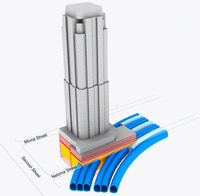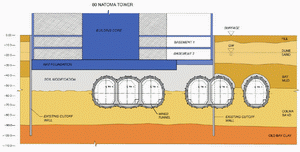Categories
You are here
Engineering Solution for Transbay Terminal, San Francisco, CA
An engineering study commisioned by the San Francisco Board of Supervisors and prepared by Cordoba/Zurinaga JV, SYSTRA Consulting Inc., Aldaron Inc., Brierley Associates, EnviroTrans Solutions Inc., Engineering and Construction Scheduling Inc. and the Dr. G. Sauer Corp. for the San Francisco County Transportation Authority provides a tunneling solution to a problem that has so far seemed nearly unsolveable:
How to safely build the 51 story 80 Natoma Tower, which is ready to break ground and accomodate the future Transbay terminal access tunnel alignment which, when built, penetrates the tower's foundation.
This solution, based on constructing the Transbay Tubes underneath the completed building using mined tunneling techniques, facilitates the construction of both the Caltrain Downtown Extension and 80 Natoma Tower as they are presently proposed and thereby satisfy both parties.

Three main solutions have been suggested:
Tunneling in / under modified soil:
Prior building the foundation of the tower a soil replacement has to be carried out. Hereby the layers of soft bay mud situated directly beneath the foundation pad are replaced by lean concrete.
After the 80 Natoma Building is completed, the Transbay Tubes will be excavated and supported underneath. The initial and final tunnel lining would be designed for the ground- and groundwater loads as well as for the dead, live and seismic loads of the building.
This solution allows the modification and optimization of the track alignment after the building is constructed.

Tunneling between drilled piers:
The foundation piles would be arranged according to the selected track alignment, in a way as to not interfere with the clearance envelopes of the trains. The tunnels would be designed to pass around the piles or to accommodate the piles in the center wall of the binocular tunnels.
As the foundation piles would support the building loads, the tunnels would only be subjected to ground and hydrostatic loads.
Lowering the tunnel alignment:
In addition to the solutions outlined above, it would be technically feasible to construct a deep tunnel alignment underneath the Tubex foundation piles.
Whatever solution is chosen it is recommended to use a mined tunneling technique under the building for the following reasons:
- Underground excavation and ground support in confined conditions is easier and safer with proven tunneling techniques than with other techniques.
- Tunneling can extend on both ends of the building, thereby minimizing surface disruption and reducing costs for utility relocations.
- It cannot be guaranteed that the piles will take their designed loads because imperfections during construction can distribute an undetermined part of the load onto the ground.
- Cut and Cover technique can mobilize lateral pressure on piles
The proposed solution presents a viable and cost effective alternative to the concepts that are presently beeing considered (moving the building, shifting alignment away from building or creating a deeper and larger cut and cover box).